
There are a lot of misconceptions about point systems and how they work. When applying in multiple states, the different types of point systems can quickly get confusing, especially since each state does it their own way and uses their own lingo. Some states have preference points, some have bonus points, some do a mix between the two, and some don’t have a point system at all. Hopefully I can clear some of that up, rather than make it even more confusing.
It’s important to know the difference between preference point systems and bonus point systems when applying for different states. In states that have a bonus point system, each point you have acts like an extra name in the hat for a random drawing. For example, if you have 5 bonus points, you will have 5 chances at drawing the tag you apply for. Pure bonus point systems won’t ever guarantee you a tag, no matter how many points you have. They give everyone a chance to draw, whether they have zero points or 20 points, and an applicant with zero points can draw a tag over the applicant with 20 points. This can be encouraging for those with few points but very discouraging for the guys who have applied for years and can’t draw a tag. In states with bonus point systems, you should always apply in the draw. The only reason to ever apply for points only in these states is if you absolutely cannot go hunting if you draw. Otherwise, you might as well throw your name in the hat. You never know, you might get lucky!
Preference point systems give tags to the applicants with the most points. In preference draws, like Colorado, you can see how many points it has taken each year to draw a certain tag and know if you have a chance to draw with the amount of points you have. This is important to know when applying because if you’re applying for a unit that took 20 points to draw last year and you have 5 points, you might as well apply for points only. You have to decide if you want to try to draw this year and select a unit that took close to the amount of points you have or less, or you can decide to build your points and wait for a better unit. The only problem there is if the unit has point creep, meaning the point level required to draw goes up every year. This is why we publish several years of data, so you can see what each unit has done historically and make an educated guess at what it will do next year.
Some states have a modified point system, which basically combines the two systems. Each state does it a little differently, but they essentially divide tags into two draws – a preference draw for those with the most points and a bonus point draw (random). Colorado does this backwards for sheep, moose, and goat as you can only get 3 preference points and then all points gained after that are bonus or “weighted” points. Since there are so many applicants with 3 preference points, you don’t even get your name in the hat until you have 3. After that, each weighted point gives you an extra chance in the random draw.
There are a few states that don’t offer a bonus point system at all, like Alaska, Idaho, and New Mexico. In this case, the draw is completely random and nobody has better odds than anybody else. These states have obvious advantages and disadvantages. You have the same chance as everybody else, but you may never draw a tag. It can be hard to justify high application and license fees if you’re not at least getting a point if you don’t draw. I applied for Idaho for the second time this year and drew an elk tag. I had no expectations whatsoever of drawing the tag. In fact, I forgot to even check my own draw results until long after I had checked them for all of my clients. If you don’t want to draw a tag this year, there is no reason to apply in states without a point system of some kind.
There are a few bonus point states that reward applicants with high points by squaring or cubing them. For example, Nevada squares your points in the draw. If you have 5 bonus points going into 2020, you would have 25 chances plus 1 for the current year, giving you 26 total chances at drawing a tag. If you don’t draw, you’d have 6 points going into 2021, giving you 37 chances in the draw.
New Mexico doesn’t have a point system, but they give you a chance to better your odds by applying in the outfitter draw as there are a certain number of tags set aside for those applying in this draw. If you plan to hire an outfitter if you draw in New Mexico, you should be applying in the outfitter draw. You have to sign a contract with the outfitter before applying and you are required to hire them if you draw. Give us a call for some outfitter recommendations sooner than later if you want to get in on that draw.
If you still have questions about point systems, feel free to give us a call.